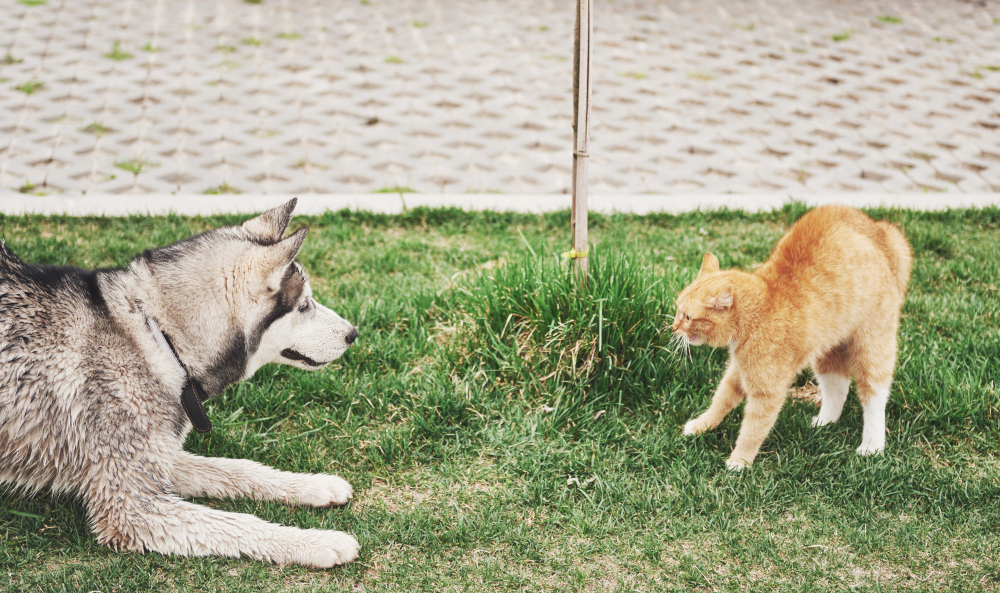Bringing a new dog into a home with a resident cat is a delicate process. While some cats will confidently investigate their new canine companion, others may retreat under the bed for days. The key to success? Go slow, watch their body language, and let the cat set the pace. Here’s a comprehensive guide to help ensure a smooth transition.
Contents
- Start with the Right Mindset
- Step 1: Create a Safe Space for Your Cat
- Step 2: Let Them Smell Before They See
- Step 3: Visual Introductions Behind a Barrier
- Step 4: Watch Body Language Like a Hawk
- Step 5: Controlled, Leashed Meetings
- Step 6: Gradually Increase Freedom
- Step 7: Know When to Pause (or Get Help)
- Bonus: Extra Comfort Tips for Cats
- Final Thoughts
Start with the Right Mindset
Every animal is unique. Your cat might be brave, curious, or territorial — or all three. Your new dog may be excitable, calm, or somewhere in between. Knowing your pets’ personalities is essential for managing expectations and making smart decisions during the introduction.
Cats, unlike dogs, are often less adaptable to sudden changes in their environment. That’s why it’s important to respect your cat’s boundaries and keep their sense of safety intact during the process.
Step 1: Create a Safe Space for Your Cat
Your cat’s comfort should be your top priority.
- Choose a secure room that your dog cannot access.
- Equip the space with a litter box, scratching post, toys, food, water, and a cozy bed.
- Use cat-friendly furniture like cat trees, shelves, or pet friendly couches to give your cat vertical territory.
This space should be your cat’s sanctuary — a place to decompress without feeling threatened.
Safety tip: Ensure any cleaning products you use are pet safe air fresheners to avoid irritating your cat’s senses.
Step 2: Let Them Smell Before They See
Before any visual contact, allow both animals to get acquainted through scent.
- Swap bedding or blankets between the cat and dog.
- Feed them on opposite sides of the door.
- Observe how each pet reacts to the other’s scent — curiosity is great, but tension or avoidance means you may need more time.
Scent-based exposure helps pets become familiar with each other in a low-stress way.
Bonus tip: Use pet waste removal services or tools to keep the shared environment clean and reduce stress-related behaviors.
Step 3: Visual Introductions Behind a Barrier
Once both animals are calm with each other’s scent, begin supervised visual introductions:
- Use a tall baby gate or pet barrier.
- Keep your dog on a leash.
- Let the cat approach at their own pace.
If your cat’s ears are forward, pupils are relaxed, and they choose to stay in the room — that’s a great sign. If the dog remains calm, offer treats and verbal praise.
If you’re relocating or staying somewhere new, look for pet friendly vacation rentals that allow room separation.
Step 4: Watch Body Language Like a Hawk
Monitoring body language is essential:
Cat Warning Signs:
- Flattened ears
- Tail flicking or swishing
- Dilated pupils
- Hissing, growling, or freezing
Dog Warning Signs:
- Fixated stare
- Whining, barking, or lunging
- Stiff posture
- Ignoring your commands
If you spot any of these, end the session calmly and go back a step.
Use this helpful chart from Petfinder for interpreting dog and cat body signals.
Step 5: Controlled, Leashed Meetings
If both pets are comfortable seeing each other through a gate, try a short leashed introduction in a common area.
- Keep the dog on a short leash with a harness or head collar.
- Let the cat roam freely, with access to vertical space.
- Ask your dog for cues like “sit” or “stay,” and reward calm behavior.
- If the dog becomes overly focused, calmly redirect with a treat or toy.
Gradually increase the length of these sessions as both animals become more relaxed.
Reminder: Never hold either pet during these meetings — if one panics or reacts, you could get scratched or bitten.
Step 6: Gradually Increase Freedom
Once both animals are showing relaxed body language, you can let them share space with the dog dragging the leash — a helpful safety measure if you need to intervene.
Make sure your cat always has an escape route — shelves, cat trees, or safe rooms. Pet friendly furniture with high platforms can make a huge difference.
Only increase their unsupervised time together when:
- The dog responds to your voice easily
- The cat chooses to stay in the room
- There are no signs of stress, stalking, or chasing
Tip: Install baby gates or a pet friendly exterminator solution for shared zones to ensure comfort and security.
Step 7: Know When to Pause (or Get Help)
It’s okay if things aren’t perfect right away. You may need to repeat earlier steps or even pause for a few days.
- Always prioritize safety
- Avoid pushing your cat — they take longer to adjust
- Use high-value treats and praise
- If necessary, seek guidance from a positive reinforcement-based trainer
In some cases, even with your best efforts, a cat may never fully warm up to a dog — and that’s okay. The goal isn’t necessarily friendship, but peaceful coexistence.
Bonus: Extra Comfort Tips for Cats
- Place pheromone diffusers like Feliway in shared areas.
- Use pet safe air fresheners to keep the environment neutral.
- Invest in pet friendly couches with washable covers for easy cleanup.
- Offer routine and structure to help reduce stress.
Moving or traveling with both pets? Explore pet friendly hotels in Nashville or other major cities to ensure comfort on the go.
Final Thoughts
Patience and understanding are the real MVPs of dog-cat introductions. Your cat may not appreciate their new dog sibling right away — but with the right approach, respect for boundaries, and a sprinkle of optimism, they might just find a way to get along.
And if you’re doing things in reverse — bringing a new cat into a dog’s domain — be sure to check out: 👉 How to Introduce a Cat to Your Dog










